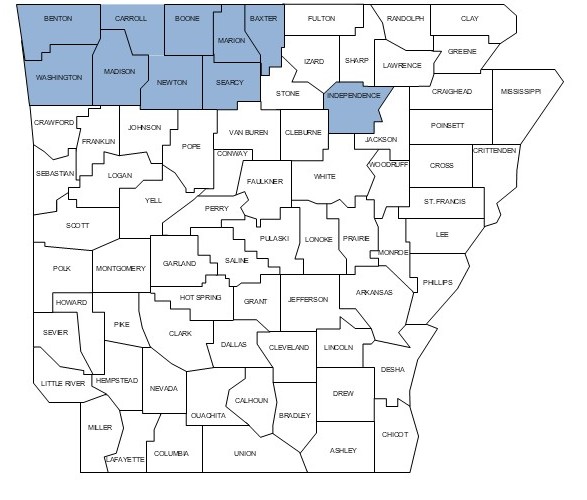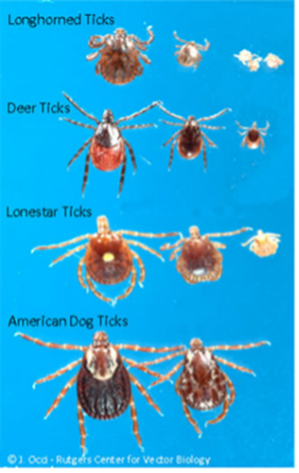Contact
Kelly M. Loftin
Professor/Extension Entomologist
Phone: 479-575-3462
Fax: 479-575-3348
Email: kloftin@uada.edu
Office:
Crawley Warren Research Lab
2601 N. Young Ave.
Fayetteville, AR 72704
Asian Longhorned Ticks and Theileriosis in Arkansas
Asian longhorned ticks (Haemaphysalis longicornis) and Theileria orientalis genotypes Ikeda and Chitose have been confirmed in Arkansas. The first confirmed cases of Theileria orientalis Ikeda in Arkansas cattle were reported in 2024. Currently, 15 Arkansas counties have confirmed cases (Fig. 1). Most of the confirmed counties were in northern Arkansas. Arkansas and Lonoke Counties are the only southeastern counties with confirmed Theileria orientalisIkedThere is no evidence that the species of Theileria found in cattle affect humans.
To date, Asian longhorned ticks have been confirmed in 10 north Arkansas counties (Fig. 2). During the 2025 “tick” season, we surveyed the counties positive for Theileria orientalis Ikeda but negative for Asian longhorned ticks and have confirmed Asian longhorned ticks in most of those Theileria positive counties. Presence of Theileria in a county indicates a strong likelihood that the Asian longhorned tick is also present.


Recent Updates
ALT and Theileriosis in AR Update - Nov. 5, 2025
Bovine Theileriosis Update – November 2025
Accredited Lab Testing
Arkansas Veterinary Diagnostic Lab (Arkansas Department of Agriculture)
AR Vet Diagnostic Lab Submission Form
Kansas Veterinary Diagnostic Lab (Kansas State University)
KS Testing Information & Submission Forms
Biology and Indentification

The ALT reproduces asexually (parthenogenesis). Females produce a large number of eggs (up to 2,000) after feeding on an animal, like a cow. All viable eggs will develop into females. No males are produced. This type of reproduction allows ALT populations to reach very high densities. ALTs are three-host ticks with four life stages – eggs, larvae, nymphs and adults. Each of the feeding stages (larvae, nymphs and adults) will feed on a different host. After larvae and nymphs feed, they drop off the host and molt into the next stage. Females that completely engorge will drop off the host and lay eggs and then die.ALTs are reddish brown ticks, void of markings, and possess short, blunt mouthparts. Adults are about 1/10 of an inch in size. ALTs are similar in size to blacklegged (deer) ticks but smaller than some of our other native ticks (Fig. 3). Their mouthparts are shorter and more angular than many of our native ticks. In addition, ALTs possess a distinctive elevated spur or “horn” on palpal segment three (Fig. 4), which can only be seen under a microscope.

Fig. 5. ALT adult and nymph – dorsal and ventral views; spur on palp.
Impact on Cattle
Because of its reproductive strategy, ALT can reach very high population densities that may result in elevated stress and has been linked to possible exsanguination of its host. In addition, it is the primary vector of theileriosis in Arkansas and U.S cattle. Theileria orientalis Ikeda genotype is“new” to Arkansas and because it infects bloodcells, its symptoms are similar to anaplasmosis.Symptoms include weakness, going off feed, palegums, jaundice, increased abortions and suddendeath. However, in contrast to anaplasmosis,theileriosis affects both calves and adult cattlewhereas anaplasmosis primarily impacts adultcattle. Currently, there are no approvedtreatments or vaccines available for theileriosis incattle.
Asian Longhorned Tick Control
Insecticide products and methods used to control horn flies on cattle can reduce the number of ALT that attach to cattle. However, some methods are more effective in controlling ticks than others. Below is a list of control methods ranked beginning with the most effective.
- Whole body insecticide/acaricide treatment – spraying (permethrin, permethrin/PBO, phosmet (Prolate/Lintox), coumaphos (Co-Ral)
- Pour-on insecticides/acaricides – pyrethroids or endectocides (Dectomax and Ivomec Pour-ons)
- Insecticide impregnated ear tags - XP820 (abamectin), others – Max40 (diazinon), Python II (zeta-cypermethrin) aid in control of ticks
- Self- treatment devices – back rubbers with face flips and dustbags
-
Both should be forced use (pass though the device daily for feed mineral or water)
-
Back rubbers – permethrin, Prolate/Lintox, Co-Ral, Ravap
- Dust bags – Python (zeta-cypermethrin), Co-Ral, permethrin
-
Although broadcast acaricide applications to the environment can be effective for use in small areas such as yards and recreational grounds, this option is not feasible for large areas such as pastures. For example, the more effective products that are broadcast against ticks are not labeled for pasture use. In addition, this type of control would be cost prohibitive and likely harm beneficial arthropods in pasture ecosystems.

A vaccine for cattle was recently developed to help control tick infestations and potentially reduce environmental populations (Medgene Labs, Brooking, SD) (Fig. 6). This vaccine is similar to the BM86 immunomodulator vaccine by Zoetis used against Rhipicephalus annulatis and R. microplus in the permanent cattle fever tick eradication area. Medgene’s vaccine works by stimulating the immune system of the animal to produce antibodies that bind to proteins in the tick’s gut. The antibodies are then ingested by the tick when it attaches and feeds on cattle that have been immunized with the vaccine. These antibodies prevent the tick from absorbing nutrients. The vaccine is reported to lessen the tick burdens on immunized cattle by reducing tick engorgement, tick growth, egg production, egg hatching and overall tick populations. Medgene’s literature also suggests that the vaccine will limit tick infestations in the environment and reduce disease transmission. Factors such as availability of non-immunized hosts (such as white-tailed deer) and other potential wildlife host species will potentially influence the vaccine’s impact on tick populations in the environment. Medgene’s vaccine is labeled against lone star tick (Amblyomma americanum), Gulf Coast tick (A. maculatum), American dog tick (Dermacentor variabilis), black-legged tick (Ixodes scapularis) and the Asian longhorned tick (Haemaphysalis longicornis). We are currently conducting a study to evaluate this vaccine’s impact on tick attachment, tick engorgement, egg production and egg hatching. In addition, we will be evaluating its influence on tick abundance in the environment and impact on Theileria transmission. This vaccine is only available through a licensed veterinarian and with approval from the Arkansas Department of Agriculture Livestock and Poultry Veterinarian.
Research Efforts
The University of Arkansas System Division of Agriculture is currently conducting a study funded by a USDA NIFA grant (USDA NIFA Award No. 2024-67016-42397) to determine the prevalence of the Asian longhorned tick and Theileria orientalis Ikeda in Arkansas. We are surveilling for Asian longhorned ticks on cattle and in the environment, as well as Theileria orientalis Ikeda in Arkansas cattle. We will identify suspect ticks collected by cattle producers, veterinarians, other state agencies and county agents. Suspect ticks can be preserved in a vial containing 90% ethanol or sent live in a vial containing a blade of grass to improve survival. Please provide name, contact information, GPS coordinates (or at least county) of collection, collection date and host (dog, cow, etc.) or environment (grass, wooded areas, edge of woods, etc.) with the sample. Samples can be returned to your local county office or sent directly to: Kelly Loftin, 2601 N. Young Ave. Fayetteville, AR 72704.
Helpful Links
Longhorned Tick - Arkansas Department of Agriculture